wheel NISSAN FRONTIER 2018 OwnerôÇs Manual
[x] Cancel search | Manufacturer: NISSAN, Model Year: 2018, Model line: FRONTIER, Model: NISSAN FRONTIER 2018Pages: 502, PDF Size: 4.85 MB
Page 2 of 502
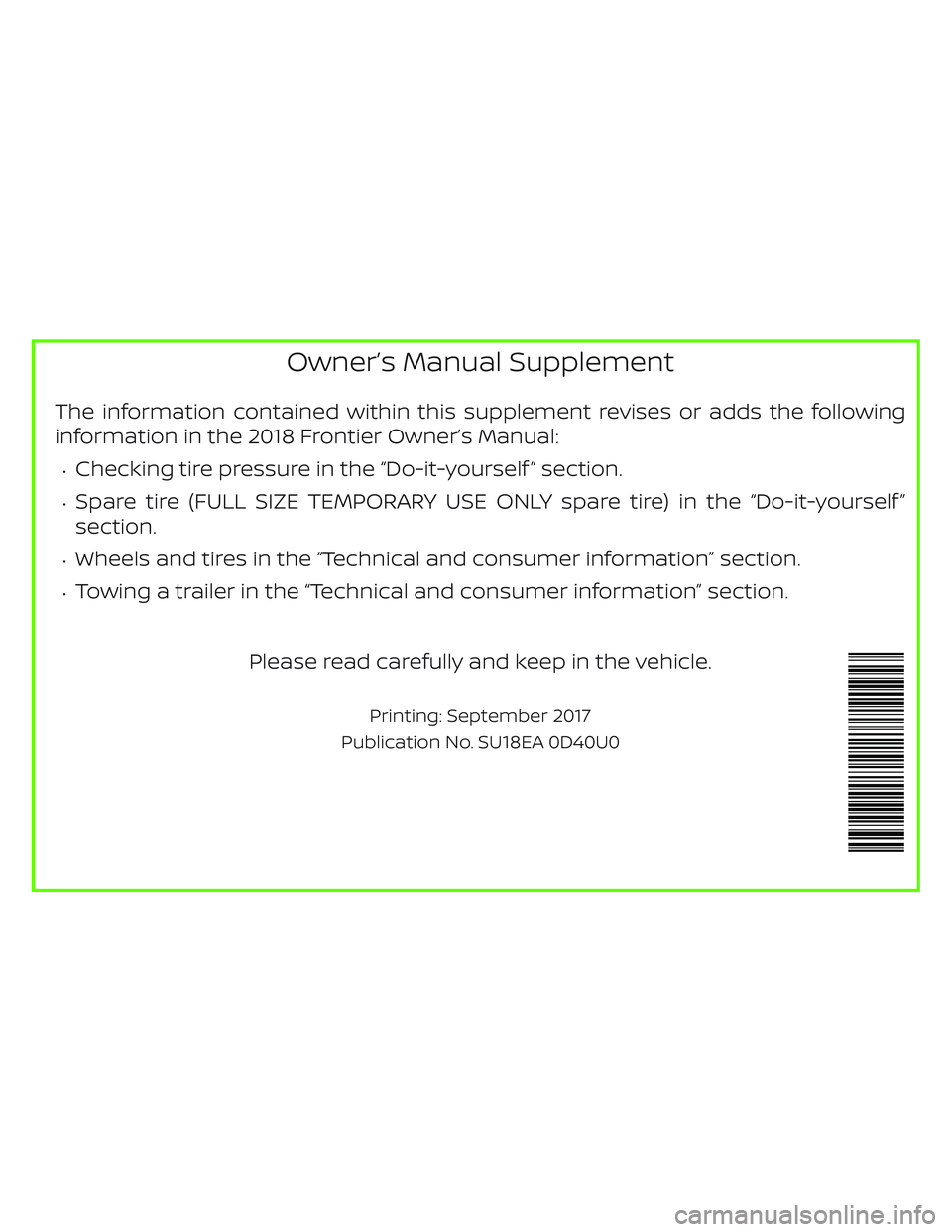
Ownerãs Manual Supplement
The information contained within this supplement revises or adds the following
information in the 2018 Frontier Ownerãs Manual:
ãChecking tire pressure in the ãDo-it-yourself ã section.
ãSpare tire (FULL SIZE TEMPORARY USE ONLY spare tire) in the ãDo-it-yourself ã
section.
ãWheels and tires in the ãTechnical and consumer informationã section.
ãTowing a trailer in the ãTechnical and consumer informationã section.
Please read carefully and keep in the vehicle.
Printing: September 2017
Publication No. SU18EA 0D40U0
Page 3 of 502
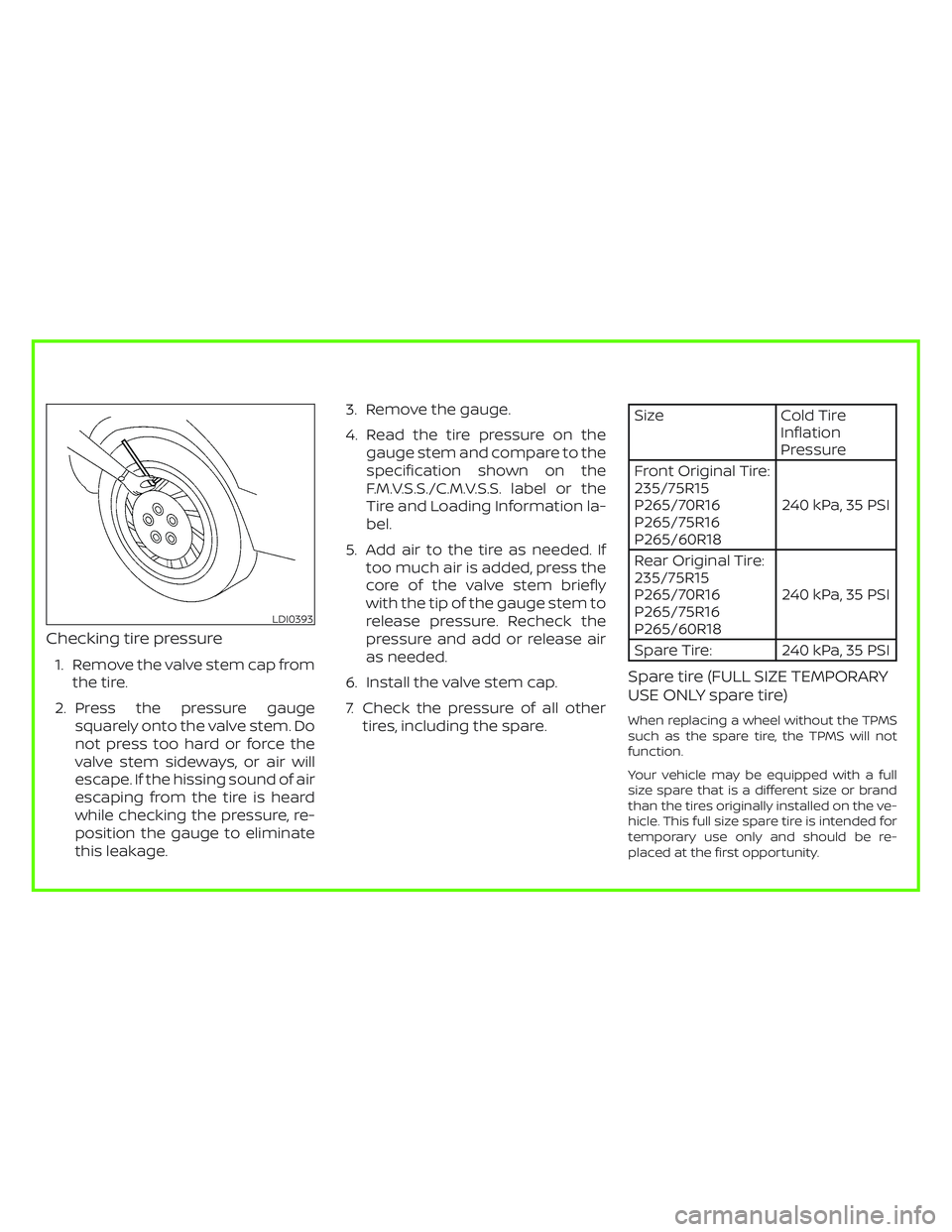
Checking tire pressure
1. Remove the valve stem cap fromthe tire.
2. Press the pressure gauge squarely onto the valve stem. Do
not press too hard or force the
valve stem sideways, or air will
escape. If the hissing sound of air
escaping from the tire is heard
while checking the pressure, re-
position the gauge to eliminate
this leakage. 3. Remove the gauge.
4. Read the tire pressure on the
gauge stem and compare to the
specification shown on the
F.M.V.S.S./C.M.V.S.S. label or the
Tire and Loading Information la-
bel.
5. Add air to the tire as needed. If too much air is added, press the
core of the valve stem briefly
with the tip of the gauge stem to
release pressure. Recheck the
pressure and add or release air
as needed.
6. Install the valve stem cap.
7. Check the pressure of all other tires, including the spare.
Size Cold Tire
Inflation
Pressure
Front Original Tire:
235/75R15
P265/70R16
P265/75R16
P265/60R18 240 kPa, 35 PSI
Rear Original Tire:
235/75R15
P265/70R16
P265/75R16
P265/60R18 240 kPa, 35 PSI
Spare Tire: 240 kPa, 35 PSI
Spare tire (FULL SIZE TEMPORARY
USE ONLY spare tire)
When replacing a wheel without the TPMS
such as the spare tire, the TPMS will not
function.
Your vehicle may be equipped with a full
size spare that is a different size or brand
than the tires originally installed on the ve-
hicle. This full size spare tire is intended for
temporary use only and should be re-
placed at the first opportunity.
LDI0393
Page 4 of 502
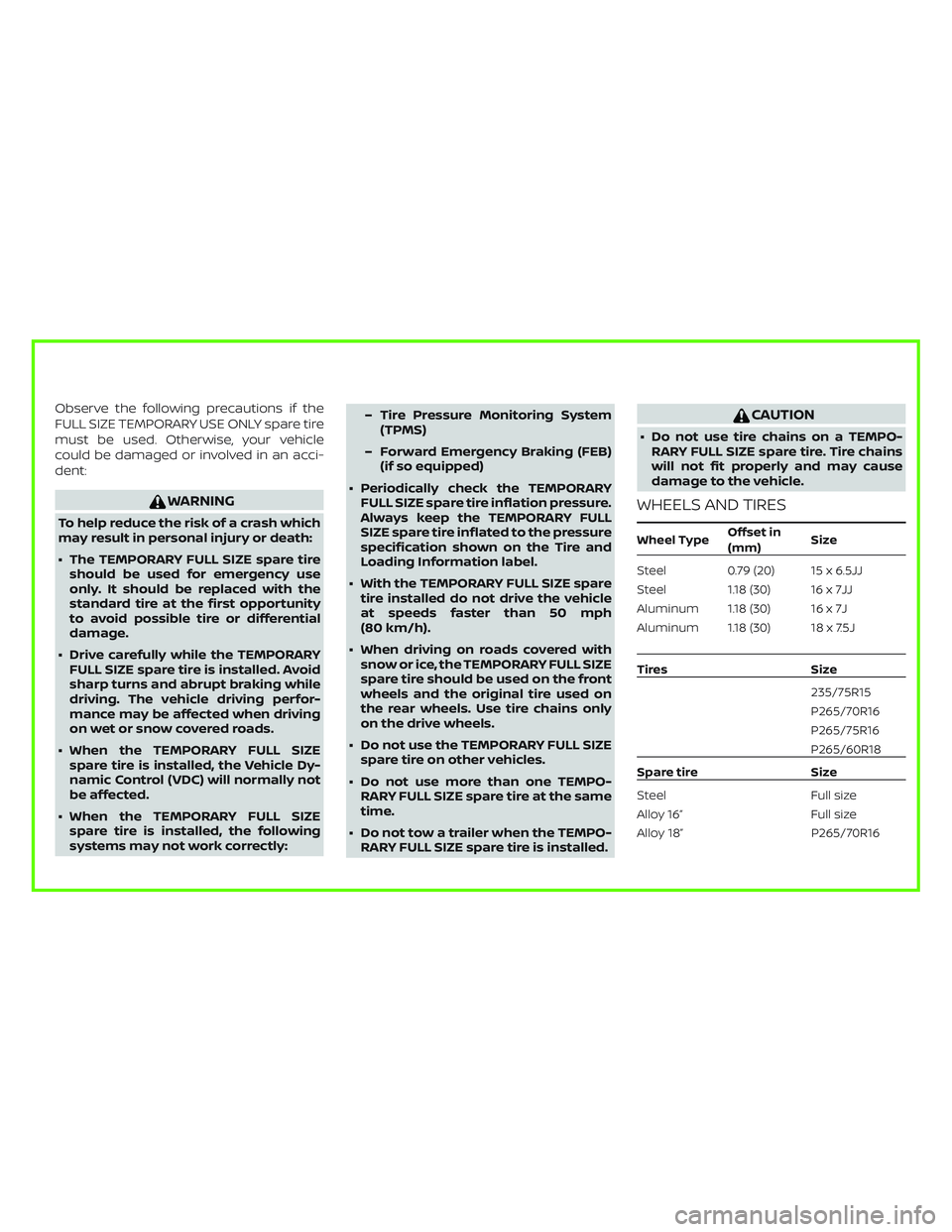
Observe the following precautions if the
FULL SIZE TEMPORARY USE ONLY spare tire
must be used. Otherwise, your vehicle
could be damaged or involved in an acci-
dent:
WARNING
To help reduce the risk of a crash which
may result in personal injury or death:
ã The TEMPORARY FULL SIZE spare tireshould be used for emergency use
only. It should be replaced with the
standard tire at the first opportunity
to avoid possible tire or differential
damage.
ã Drive carefully while the TEMPORARY FULL SIZE spare tire is installed. Avoid
sharp turns and abrupt braking while
driving. The vehicle driving perfor-
mance may be affected when driving
on wet or snow covered roads.
ã When the TEMPORARY FULL SIZE spare tire is installed, the Vehicle Dy-
namic Control (VDC) will normally not
be affected.
ã When the TEMPORARY FULL SIZE spare tire is installed, the following
systems may not work correctly: ã Tire Pressure Monitoring System
(TPMS)
ã Forward Emergency Braking (FEB) (if so equipped)
ã Periodically check the TEMPORARY FULL SIZE spare tire inflation pressure.
Always keep the TEMPORARY FULL
SIZE spare tire inflated to the pressure
specification shown on the Tire and
Loading Information label.
ã With the TEMPORARY FULL SIZE spare tire installed do not drive the vehicle
at speeds faster than 50 mph
(80 km/h).
ã When driving on roads covered with snow or ice, the TEMPORARY FULL SIZE
spare tire should be used on the front
wheels and the original tire used on
the rear wheels. Use tire chains only
on the drive wheels.
ã Do not use the TEMPORARY FULL SIZE spare tire on other vehicles.
ã Do not use more than one TEMPO- RARY FULL SIZE spare tire at the same
time.
ã Do not tow a trailer when the TEMPO- RARY FULL SIZE spare tire is installed.
CAUTION
ã Do not use tire chains on a TEMPO-RARY FULL SIZE spare tire. Tire chains
will not fit properly and may cause
damage to the vehicle.
WHEELS AND TIRES
Wheel Type Offset in
(mm)Size
Steel 0.79 (20) 15 x 6.5JJ
Steel 1.18 (30) 16 x 7JJ
Aluminum 1.18 (30) 16 x 7J
Aluminum 1.18 (30) 18 x 7.5J
Tires Size 235/75R15
P265/70R16
P265/75R16
P265/60R18
Spare tire Size
Steel Full size
Alloy 16ã Full size
Alloy 18ã P265/70R16
Page 7 of 502
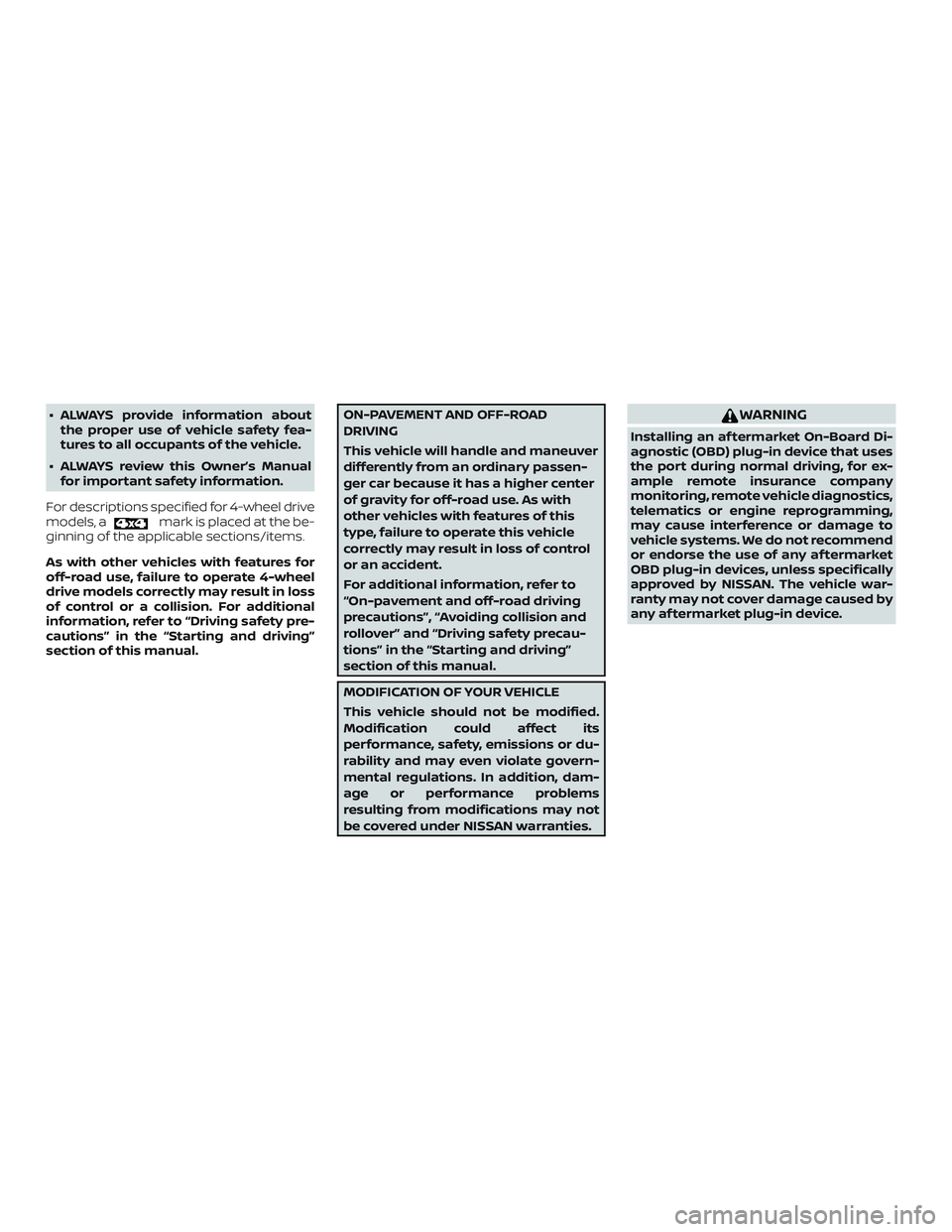
ã ALWAYS provide information aboutthe proper use of vehicle safety fea-
tures to all occupants of the vehicle.
ã ALWAYS review this Ownerãs Manual for important safety information.
For descriptions specified for 4-wheel drive
models, a
mark is placed at the be-
ginning of the applicable sections/items.
As with other vehicles with features for
off-road use, failure to operate 4-wheel
drive models correctly may result in loss
of control or a collision. For additional
information, refer to ãDriving safety pre-
cautionsã in the ãStarting and drivingã
section of this manual.
ON-PAVEMENT AND OFF-ROAD
DRIVING
This vehicle will handle and maneuver
differently from an ordinary passen-
ger car because it has a higher center
of gravity for off-road use. As with
other vehicles with features of this
type, failure to operate this vehicle
correctly may result in loss of control
or an accident.
For additional information, refer to
ãOn-pavement and off-road driving
precautionsã, ãAvoiding collision and
rolloverã and ãDriving safety precau-
tionsã in the ãStarting and drivingã
section of this manual.
MODIFICATION OF YOUR VEHICLE
This vehicle should not be modified.
Modification could affect its
performance, safety, emissions or du-
rability and may even violate govern-
mental regulations. In addition, dam-
age or performance problems
resulting from modifications may not
be covered under NISSAN warranties.
WARNING
Installing an af termarket On-Board Di-
agnostic (OBD) plug-in device that uses
the port during normal driving, for ex-
ample remote insurance company
monitoring, remote vehicle diagnostics,
telematics or engine reprogramming,
may cause interference or damage to
vehicle systems. We do not recommend
or endorse the use of any af termarket
OBD plug-in devices, unless specifically
approved by NISSAN. The vehicle war-
ranty may not cover damage caused by
any af termarket plug-in device.
Page 19 of 502
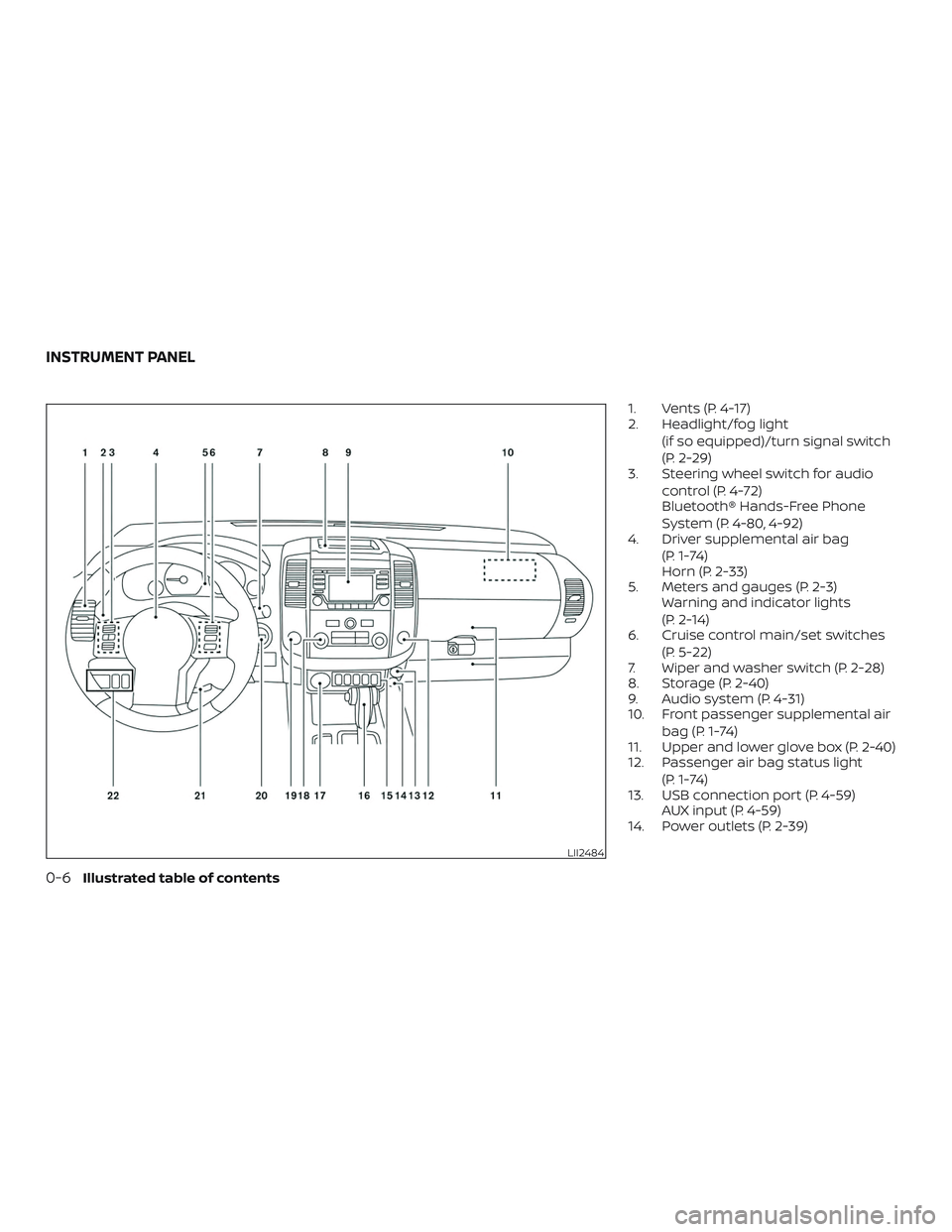
1. Vents (P. 4-17)
2. Headlight/fog light(if so equipped)/turn signal switch
(P. 2-29)
3. Steering wheel switch for audio
control (P. 4-72)
BluetoothôÛ Hands-Free Phone
System (P. 4-80, 4-92)
4. Driver supplemental air bag
(P. 1-74)
Horn (P. 2-33)
5. Meters and gauges (P. 2-3) Warning and indicator lights
(P. 2-14)
6. Cruise control main/set switches
(P. 5-22)
7. Wiper and washer switch (P. 2-28)
8. Storage (P. 2-40)
9. Audio system (P. 4-31)
10. Front passenger supplemental air
bag (P. 1-74)
11. Upper and lower glove box (P. 2-40)
12. Passenger air bag status light
(P. 1-74)
13. USB connection port (P. 4-59) AUX input (P. 4-59)
14. Power outlets (P. 2-39)
LII2484
INSTRUMENT PANEL
0-6Illustrated table of contents
Page 20 of 502
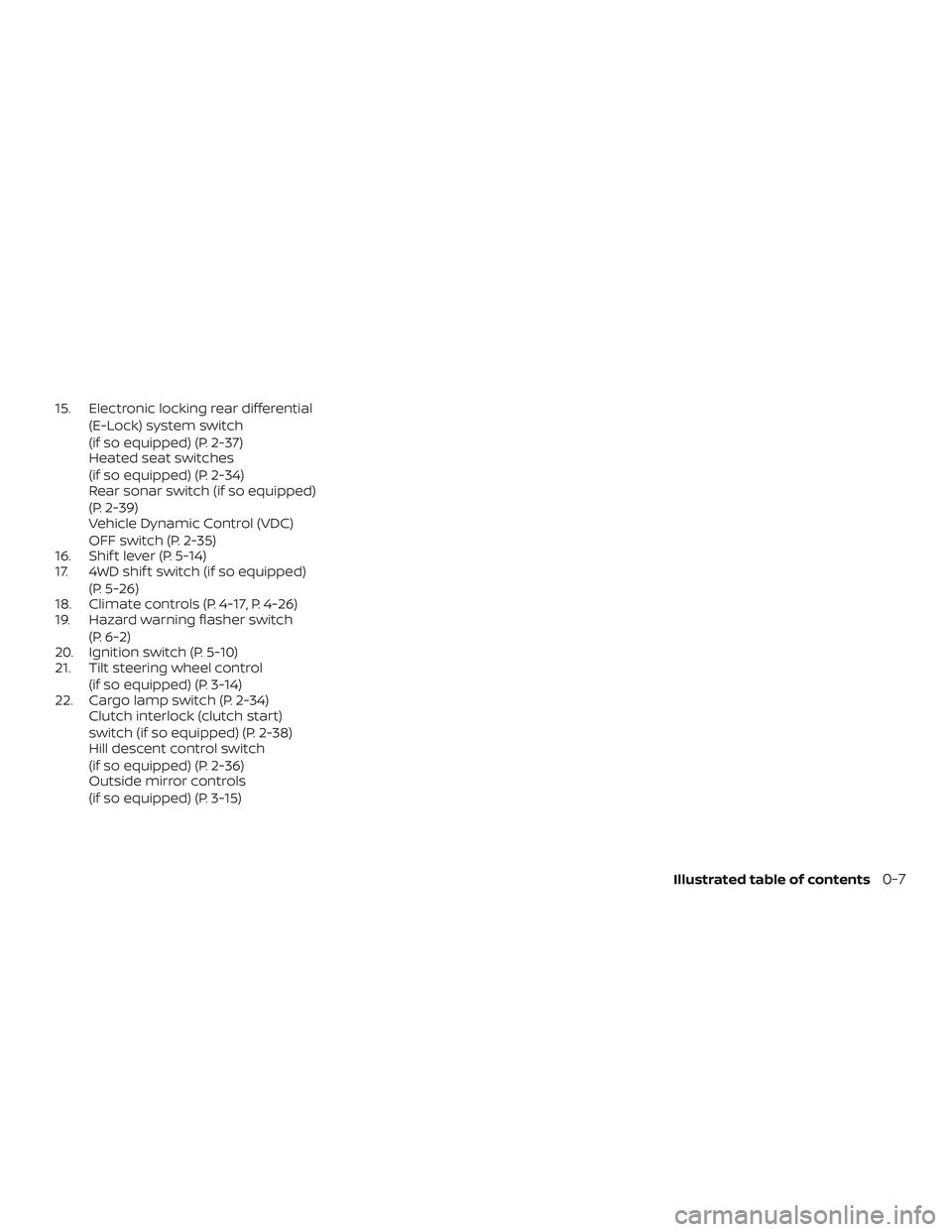
15. Electronic locking rear differential(E-Lock) system switch
(if so equipped) (P. 2-37)
Heated seat switches
(if so equipped) (P. 2-34)
Rear sonar switch (if so equipped)
(P. 2-39)
Vehicle Dynamic Control (VDC)
OFF switch (P. 2-35)
16. Shif t lever (P. 5-14)
17. 4WD shif t switch (if so equipped)
(P. 5-26)
18. Climate controls (P. 4-17, P. 4-26)
19. Hazard warning flasher switch
(P. 6-2)
20. Ignition switch (P. 5-10)
21. Tilt steering wheel control
(if so equipped) (P. 3-14)
22. Cargo lamp switch (P. 2-34) Clutch interlock (clutch start)
switch (if so equipped) (P. 2-38)
Hill descent control switch
(if so equipped) (P. 2-36)
Outside mirror controls
(if so equipped) (P. 3-15)
Illustrated table of contents
0-7
Page 99 of 502
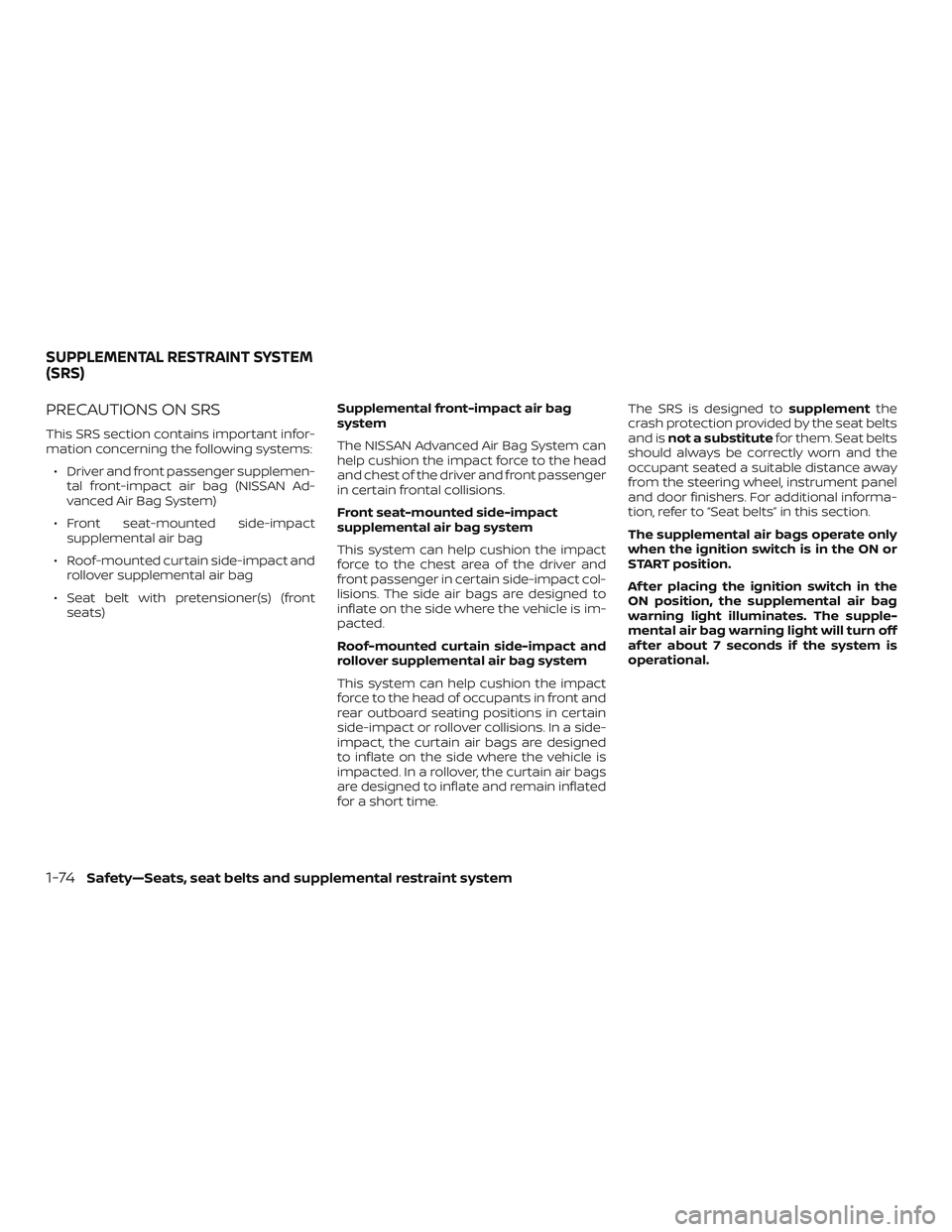
PRECAUTIONS ON SRS
This SRS section contains important infor-
mation concerning the following systems:ã Driver and front passenger supplemen- tal front-impact air bag (NISSAN Ad-
vanced Air Bag System)
ã Front seat-mounted side-impact supplemental air bag
ã Roof-mounted curtain side-impact and rollover supplemental air bag
ã Seat belt with pretensioner(s) (front seats) Supplemental front-impact air bag
system
The NISSAN Advanced Air Bag System can
help cushion the impact force to the head
and chest of the driver and front passenger
in certain frontal collisions.
Front seat-mounted side-impact
supplemental air bag system
This system can help cushion the impact
force to the chest area of the driver and
front passenger in certain side-impact col-
lisions. The side air bags are designed to
inflate on the side where the vehicle is im-
pacted.
Roof-mounted curtain side-impact and
rollover supplemental air bag system
This system can help cushion the impact
force to the head of occupants in front and
rear outboard seating positions in certain
side-impact or rollover collisions. In a side-
impact, the curtain air bags are designed
to inflate on the side where the vehicle is
impacted. In a rollover, the curtain air bags
are designed to inflate and remain inflated
for a short time. The SRS is designed to
supplementthe
crash protection provided by the seat belts
and is not a substitute for them. Seat belts
should always be correctly worn and the
occupant seated a suitable distance away
from the steering wheel, instrument panel
and door finishers. For additional informa-
tion, refer to ãSeat beltsã in this section.
The supplemental air bags operate only
when the ignition switch is in the ON or
START position.
Af ter placing the ignition switch in the
ON position, the supplemental air bag
warning light illuminates. The supple-
mental air bag warning light will turn off
af ter about 7 seconds if the system is
operational.
SUPPLEMENTAL RESTRAINT SYSTEM
(SRS)
1-74SafetyãSeats, seat belts and supplemental restraint system
Page 100 of 502
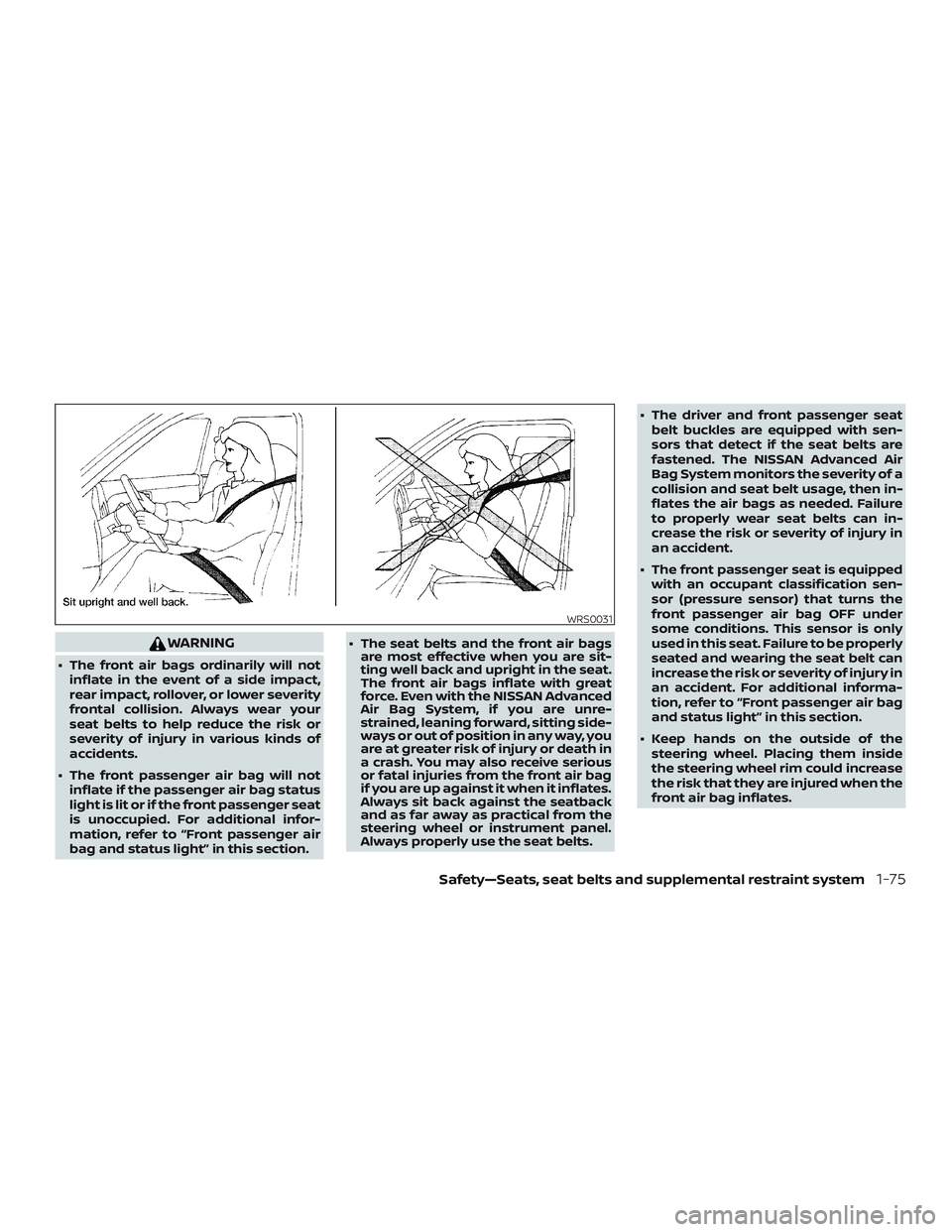
WARNING
ã The front air bags ordinarily will notinflate in the event of a side impact,
rear impact, rollover, or lower severity
frontal collision. Always wear your
seat belts to help reduce the risk or
severity of injury in various kinds of
accidents.
ã The front passenger air bag will not inflate if the passenger air bag status
light is lit or if the front passenger seat
is unoccupied. For additional infor-
mation, refer to ãFront passenger air
bag and status lightã in this section. ã The seat belts and the front air bags
are most effective when you are sit-
ting well back and upright in the seat.
The front air bags inflate with great
force. Even with the NISSAN Advanced
Air Bag System, if you are unre-
strained, leaning forward, sitting side-
ways or out of position in any way, you
are at greater risk of injury or death in
a crash. You may also receive serious
or fatal injuries from the front air bag
if you are up against it when it inflates.
Always sit back against the seatback
and as far away as practical from the
steering wheel or instrument panel.
Always properly use the seat belts. ã The driver and front passenger seat
belt buckles are equipped with sen-
sors that detect if the seat belts are
fastened. The NISSAN Advanced Air
Bag System monitors the severity of a
collision and seat belt usage, then in-
flates the air bags as needed. Failure
to properly wear seat belts can in-
crease the risk or severity of injury in
an accident.
ã The front passenger seat is equipped with an occupant classification sen-
sor (pressure sensor) that turns the
front passenger air bag OFF under
some conditions. This sensor is only
used in this seat. Failure to be properly
seated and wearing the seat belt can
increase the risk or severity of injury in
an accident. For additional informa-
tion, refer to ãFront passenger air bag
and status lightã in this section.
ã Keep hands on the outside of the steering wheel. Placing them inside
the steering wheel rim could increase
the risk that they are injured when the
front air bag inflates.
WRS0031
SafetyãSeats, seat belts and supplemental restraint system1-75
Page 107 of 502

This vehicle is equipped with the NISSAN
Advanced Air Bag System for the driver and
front passenger seats. This system is de-
signed to meet certification requirements
under U.S. regulations. It is also permitted in
Canada.However, all of the information,
cautions and warnings in this manual
still apply and must be followed.
The driver supplemental front-impact air
bag is located in the center of the steering
wheel. The front passenger supplemental
front-impact air bag is mounted in the
dashboard above the glove box. The front
air bags are designed to inflate in higher
severity frontal collisions, although they
may inflate if the forces in another type of
collision are similar to those of a higher
severity frontal impact. They may not in-
flate in certain frontal collisions. Vehicle
damage (or lack of it) is not always an indi-
cation of proper front air bag system op-
eration.
The NISSAN Advanced Air Bag System
monitors information from the crash zone
sensor, the Air bag Control Unit (ACU), seat
belt buckle sensors, occupant classifica-
tion sensor (pressure sensor) and passen-
ger seat belt tension sensor. Inflator opera-
tion is based on the severity of a collision
and seat belt usage for the driver. For the front passenger, it additionally monitors
the weight of an occupant or object on the
seat and seat belt tension. Based on infor-
mation from the sensors, only one front air
bag may inflate in a crash, depending on
the crash severity and whether the front
occupants are belted or unbelted. Addi-
tionally, the front passenger air bag may be
automatically turned off under some con-
ditions, depending on the weight detected
on the front passenger seat and how the
seat belt is used. If the front passenger air
bag is OFF, the front passenger air bag sta-
tus light will be illuminated (if the seat is
unoccupied, the light will not be illumi-
nated, but the air bag will be off ). For addi-
tional information, refer to ãFront passen-
ger air bag and status lightã in this section.
One front air bag inflating does not indicate
improper performance of the system.
If you have any questions about your air
bag system, it is recommended that you
visit a NISSAN dealer to obtain information
about the system. If you are considering
modification of your vehicle due to a dis-
ability, you may also contact NISSAN. Con-
tact information is contained in the front of
this Ownerãs Manual.
When a front air bag inflates, a fairly loud
noise may be heard, followed by the re-lease of smoke. This smoke is not harmful
and does not indicate a fire. Care should be
taken to not inhale it, as it may cause irrita-
tion and choking. Those with a history of a
breathing condition should get fresh air
promptly.
Front air bags, along with the use of seat
belts, help to cushion the impact force on
the face and chest of the front occupants.
They can help save lives and reduce seri-
ous injuries. However, an inflating front air
bag may cause facial abrasions or other
injuries. Front air bags do not provide re-
straint to the lower body.
Even with NISSAN Advanced Air Bags, seat
belts should be correctly worn and the
driver and front passenger seated upright
as far as practical away from the steering
wheel or instrument panel. The front air
bags inflate quickly in order to help protect
the front occupants. Because of this, the
force of the front air bag inflating can in-
crease the risk of injury if the occupant is
too close to, or is against, the front air bag
module during inflation.
The front air bags deflate quickly af ter a
collision.
1-82SafetyãSeats, seat belts and supplemental restraint system
Page 110 of 502
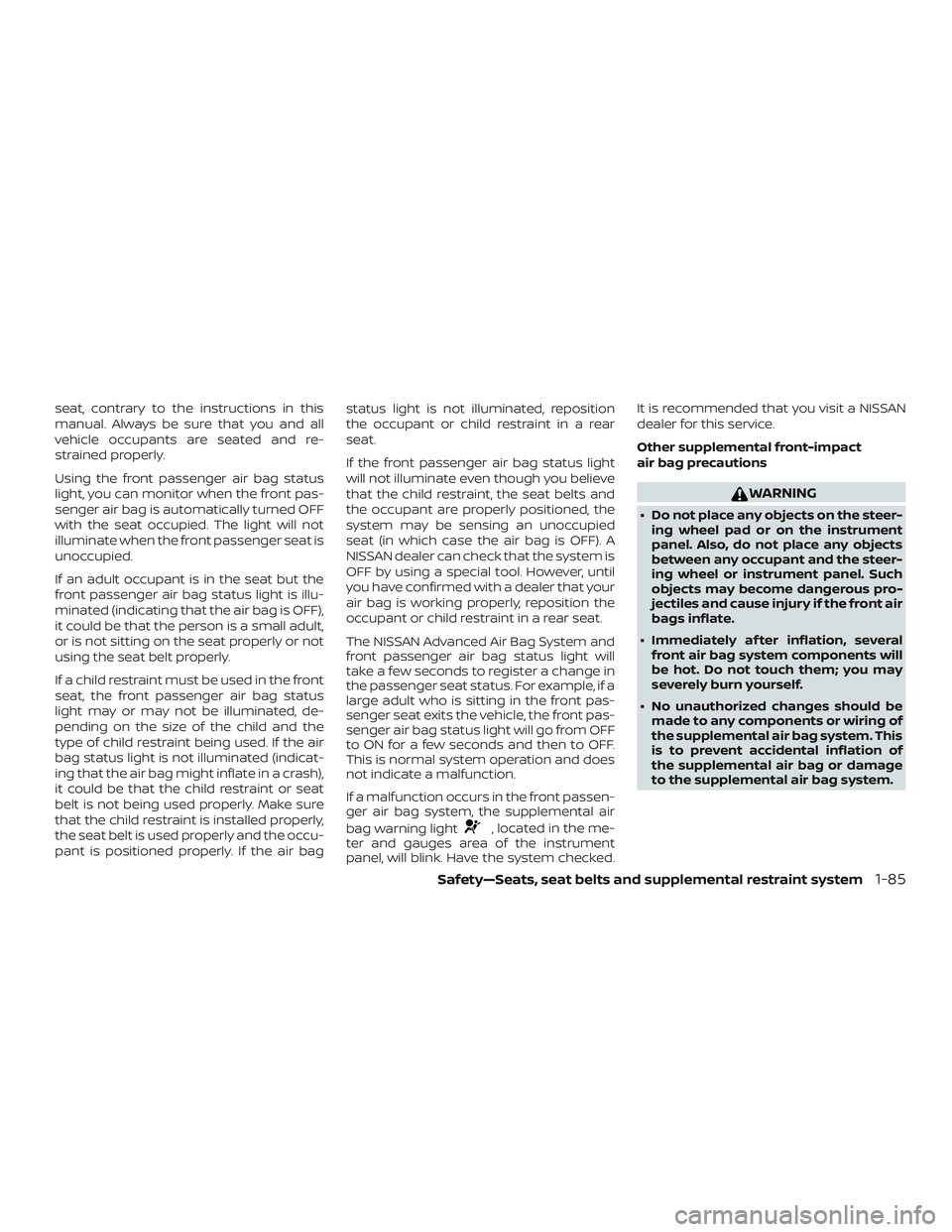
seat, contrary to the instructions in this
manual. Always be sure that you and all
vehicle occupants are seated and re-
strained properly.
Using the front passenger air bag status
light, you can monitor when the front pas-
senger air bag is automatically turned OFF
with the seat occupied. The light will not
illuminate when the front passenger seat is
unoccupied.
If an adult occupant is in the seat but the
front passenger air bag status light is illu-
minated (indicating that the air bag is OFF),
it could be that the person is a small adult,
or is not sitting on the seat properly or not
using the seat belt properly.
If a child restraint must be used in the front
seat, the front passenger air bag status
light may or may not be illuminated, de-
pending on the size of the child and the
type of child restraint being used. If the air
bag status light is not illuminated (indicat-
ing that the air bag might inflate in a crash),
it could be that the child restraint or seat
belt is not being used properly. Make sure
that the child restraint is installed properly,
the seat belt is used properly and the occu-
pant is positioned properly. If the air bagstatus light is not illuminated, reposition
the occupant or child restraint in a rear
seat.
If the front passenger air bag status light
will not illuminate even though you believe
that the child restraint, the seat belts and
the occupant are properly positioned, the
system may be sensing an unoccupied
seat (in which case the air bag is OFF). A
NISSAN dealer can check that the system is
OFF by using a special tool. However, until
you have confirmed with a dealer that your
air bag is working properly, reposition the
occupant or child restraint in a rear seat.
The NISSAN Advanced Air Bag System and
front passenger air bag status light will
take a few seconds to register a change in
the passenger seat status. For example, if a
large adult who is sitting in the front pas-
senger seat exits the vehicle, the front pas-
senger air bag status light will go from OFF
to ON for a few seconds and then to OFF.
This is normal system operation and does
not indicate a malfunction.
If a malfunction occurs in the front passen-
ger air bag system, the supplemental air
bag warning light
, located in the me-
ter and gauges area of the instrument
panel, will blink. Have the system checked. It is recommended that you visit a NISSAN
dealer for this service.
Other supplemental front-impact
air bag precautions
WARNING
ã Do not place any objects on the steer-
ing wheel pad or on the instrument
panel. Also, do not place any objects
between any occupant and the steer-
ing wheel or instrument panel. Such
objects may become dangerous pro-
jectiles and cause injury if the front air
bags inflate.
ã Immediately af ter inflation, several front air bag system components will
be hot. Do not touch them; you may
severely burn yourself.
ã No unauthorized changes should be made to any components or wiring of
the supplemental air bag system. This
is to prevent accidental inflation of
the supplemental air bag or damage
to the supplemental air bag system.
SafetyãSeats, seat belts and supplemental restraint system1-85